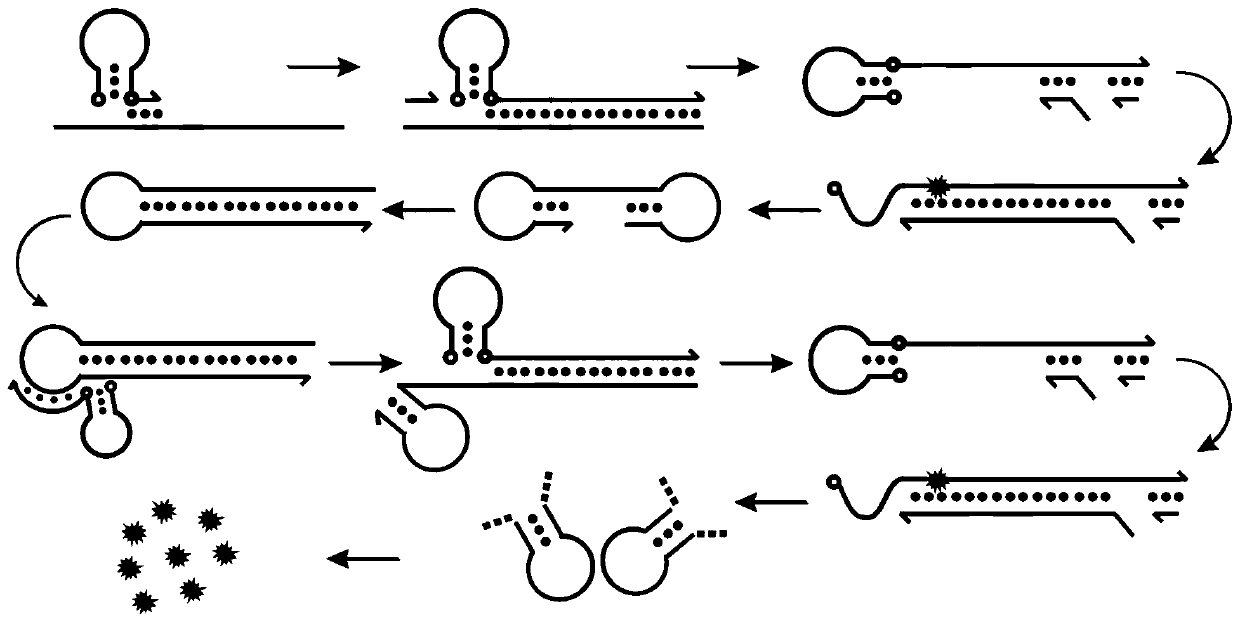Multi-target gene parallel detection combined probe and application thereof
A combined probe and multi-target technology, used in recombinant DNA technology, microbial determination/inspection, DNA/RNA fragments, etc., can solve the problems of multiple types of primers, high concentration, detection cross-interference, etc., and achieve strong exponential amplification ability, improved accuracy and specificity, and structurally stable effects
- Summary
- Abstract
- Description
- Claims
- Application Information
AI Technical Summary
Problems solved by technology
Method used
Image
Examples
Embodiment 1
[0061] The multi-target gene parallel detection of the above-mentioned combination probe type B hepatitis B virus of embodiment 1
[0062] combine Figure 7 In the detection results shown, channels 1, 2, 3, and 4 correspond to the fluorescent signals of Tex, Hex, FAM, and Cy5, respectively. When hepatitis B exists in the system, FIP-Hex and BIP-Tex interact with the target S gene and C gene respectively, and channels 1 and 2 both generate strong fluorescent signals. The amplification product of LAMP is completely complementary to the cohesive end of the B-type specific hybridization structure probe (LF-FAM / LF Block BHQ2), which can produce a strong Toe-hold displacement, and channel 3 can collect strong FAM fluorescence . Simultaneously displacing the bound FAM fluorescent probe can be used as a loop primer to accelerate the amplification of the hepatitis B S gene. Due to the base difference between hepatitis B virus type B and type C hepatitis B virus genome, the ability o...
Embodiment 2
[0063] Example 2 The above combined probes can be used for parallel detection of multi-target genes of hepatitis B virus
[0064] combine Figure 8 In the detection results shown, channels 1, 2, 3, and 4 correspond to the fluorescent signals of Tex, Hex, FAM, and Cy5, respectively. When hepatitis B exists in the system, FIP-Hex and BIP-Tex interact with the target S gene and C gene respectively, and channels 1 and 2 both generate strong fluorescent signals. The amplification product of LAMP is completely complementary to the cohesive end of the C-type specific hybridization structure probe (LB-Cy5 / LB Block BHQ2), which can produce a strong Toe-hold displacement, and channel 4 can collect strong FAM fluorescence . Simultaneously displacing the bound Cy5 fluorescent probe can be used as a loop primer to accelerate the amplification of the hepatitis C S gene. Due to the base difference between hepatitis B virus and hepatitis B virus genome, the ability of the above-mentioned L...
Embodiment 3
[0065] Example 3 The above combined probes can be used for parallel detection and typing of multiple target genes of hepatitis B virus in clinical serum samples
[0066] 300 μL of serum samples were collected from 24 patients with hepatitis B, and the virus genome in the serum was extracted with a commercial kit. Through the effective integration of multi-channel information and mutual verification of data, high-quality data for target quantification and typing can be accurately obtained. The result is as Figure 9 As shown: samples No. 2 and No. 14 are hepatitis B virus, samples No. 1 and 11 are other subtypes of hepatitis B virus, and the rest are hepatitis B virus type C. The above results are consistent with the sequencing results.
[0067] In summary, the present invention constructs a multiplex LAMP amplification system, and the signal probe combination includes: a pair of stem-loop structure probes (FIP-Hex, BIP-Tex), a pair of hybridization structure probes (LF-FAM / LF...
PUM
 Login to View More
Login to View More Abstract
Description
Claims
Application Information
 Login to View More
Login to View More - R&D Engineer
- R&D Manager
- IP Professional
- Industry Leading Data Capabilities
- Powerful AI technology
- Patent DNA Extraction
Browse by: Latest US Patents, China's latest patents, Technical Efficacy Thesaurus, Application Domain, Technology Topic, Popular Technical Reports.
© 2024 PatSnap. All rights reserved.Legal|Privacy policy|Modern Slavery Act Transparency Statement|Sitemap|About US| Contact US: help@patsnap.com










